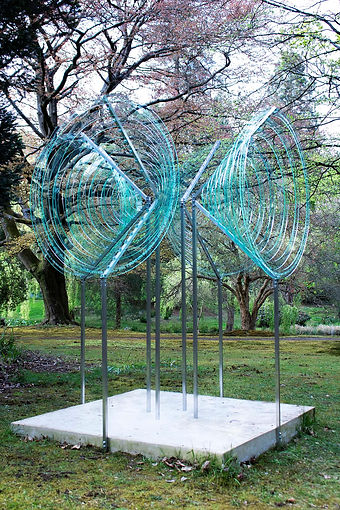THEY ARE OFTEN CALLED SINGERS
WINNER OF 2022 SPOTLIGHT AWARD

ALUMINIUM AND PERSPEX ACRYLICS
200 X 168 X 168 CM
Growing urban populations require additional infrastructure, which in already dense population areas means taller buildings. In London alone, more than 200 tall building projects have been built or have started construction in the last 10 years (CTBUH Skyscraper Center 2020), and according to New London Architecture's annual review there are a total of 587 “tall buildings” in project in London, with 310 in full planning permission and 127 under consideration.
But while the benefits of such structures are many, they can have a detrimental environmental impact on their surroundings.
In 1980, City of London planners earmarked an area known as the Eastern Cluster for the development of tall buildings above the medieval tapestry of narrow passageways and streets, in response to the increasing demand for office space. Since then, this area has become home to a series of skyscrapers, synonymous with London's financial prowess and power; also, synonymous with strong winds and large shady areas, which is already an everyday experience.


They Are Often Called Singers works as a poetic instrument of communication, focusing its narrative on the "wind microclimate" and on how the imposing vertical architecture of the Eastern Cluster of the City of London originates frenetic wind phenomena capable of modifying the qualities of thermal comfort, generating specific microclimates in the urban framework and thus dramatically affecting public spaces, compromising their use. This could be understood as a phenomenon that ceases to be fully meteorological to become subject to other power infrastructures which manage the urban and architectural development of the city.
It is part of a larger ongoing project, which investigates through different artistic territories between visual and sound, the confluence of urbanism and the interpretation of the conditions and experiences of people in those urban environments of London. In this way, it raises questions that seek to open new spaces for dialogue in the relationships between design ideas, the built form and social life.
The idea is to encourage questioning as a starting point, and not as an answer.
The piece invites us to explore space in another way, understanding the parts that make up its structure, turning contemplation into an activity and observation into a journey. The fine aluminum structures sustain the presence of the act of building as a continuous process, while its transparent rings make it intimately related to its surroundings, pushing our perception to the limit and mutating as we move through space, constantly redefining our experience. The geometric interconnections develop a rhythm, creating and recreating a relationship that facilitates a visual and mental engagement with the work, where the object is an idea, but the idea ultimately resolves into a presence.
Through a network of associations and analogies in which E. Canetti addresses the concept of the wind (Crowds and Power, 1960), I open a semantic space by establishing an interaction between what the words suggest, what memories are invoked and imagination. In this way, written language triggers the configuration of images, which invoke and reinvest the interior of the representation and create a tone that allows us to delineate invisible and abstract things. Then the landscapes appear: The interior landscapes.
This is precisely what helps me to be able to articulate my own experience and that of the spectator. Each text is a three-dimensional object, an autonomous sculptural phenomenon that allows us to live within it, that accompanies us throughout the journey and uses light to present us with a constellation made up of words, one on top of the other, where poetic language seems float freely in space permeating the surrounding natural context.







